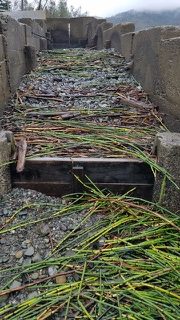
Amidst the tumultuous relicensing, auction, bankruptcy, and withdrawal developments for the Eel River dams, attention has largely centered around the most problematic of the two – Scott Dam, which is structurally unsound and has zero fish passage.
However, while there is a fish ladder at the Van Arsdale Fish Station at Cape Horn Dam, recent events have highlighted the system’s vulnerablility to higher flows. This February, flows peaking at more than 16,000 cfs and then 30,000 cfs left the fish ladder clogged with debris and sediment, impassible to the steelhead whose migration runs through early April. PG&E initially refused to commit to clearing the ladder sooner than March 18. Our letter to FERC last Friday morning may have helped PG&E decide to get the dive crews on site this Monday the 11th.
Having the fish ladder blocked after big storms is a serious problem. But it’s not the only problem the Cape Horn fish ladder has with higher flows. At flows above about 2000 cfs, the intake structure (the ‘fish hotel’) produces flows of such velocity that fish can’t find their way into the ladder.
So while the ladder may function adequately at average flows, it doesn’t allow fish to move upriver during higher flows, and especially on the recessional limb of big storms. Those are problems we’re going to need to address as the future of the Eel River dams is resolved.
